I have to admit that I love hiking the Narrows Zion National Park! It has all the elements making for an unforgettable experience including exciting places to visit, jaw-dropping views, the element of risk and hiking through a river.
I have been asked numerous times if this Zion hike lives up to all of its hype, the answer is always YES! The Zion Narrows hike takes you on a journey into a breathtaking slot canyon that has been carved out of brilliant red sandstone rock by the Virgin River.
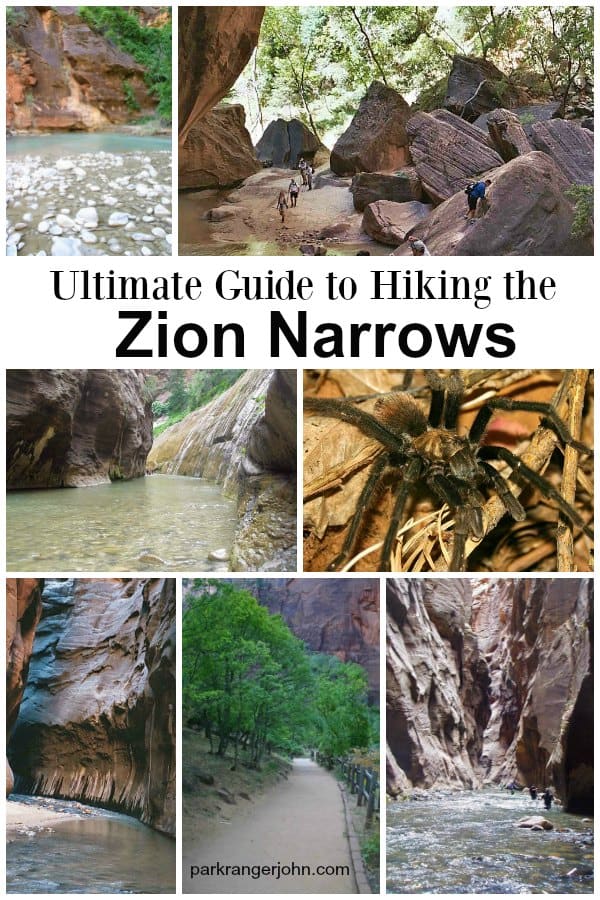
Hiking The Narrows Zion National Park
By the time you finish this article you will know the two hiking routes into the narrows and which one you want to take, the equipment you will need to complete the hike safely and enjoy the hike, know how to get to the Zion Narrows and have a map, when and what time of year to hike the Narrows and have a strong understanding of the importance of knowing the weather and recognizing dangers of flash flooding before you go.
I will also discuss if you will need a wilderness permit and how to obtain one, how to use the Zion National Parks shuttle system, and if you will need to get a private company for transportation.
Having hiked this trail several times, I wanted to offer some very practical tips and tricks for hiking the Narrows Zion NP. First-time hikers can hike in confidence that they are prepared for an adventure of a lifetime!
Trust me hiking the Narrows is one of the top things to do in Zion National Park that you do not want to miss!
Zion National Park Narrows Hiking Routes
Zion Narrows Map
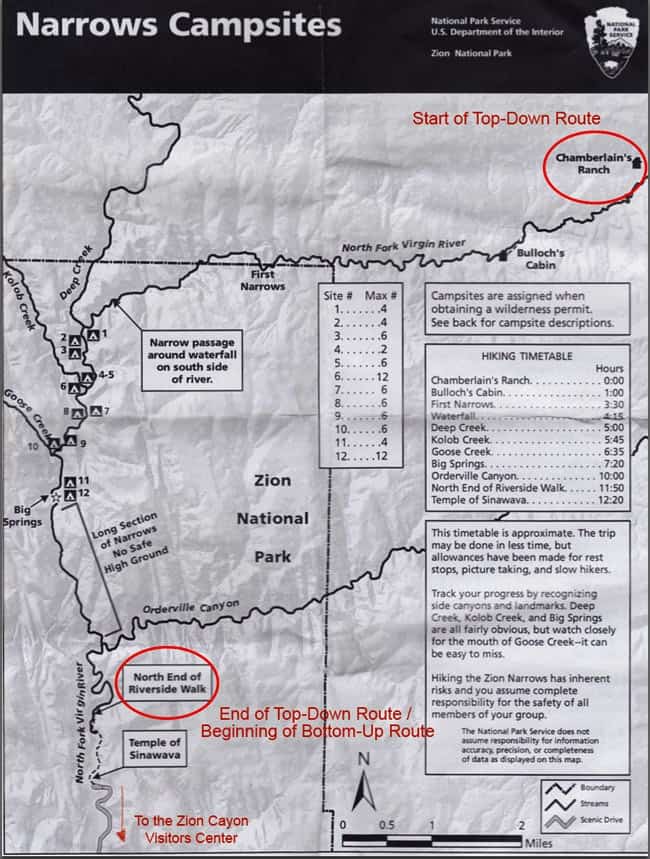
The first step is to decide if you are going to hike the Narrows as a day hike or take the more strenuous 16-mile top-down hike and possibly camping in the Zion Canyon.
The day hike is by far the most popular and takes much less preparation as you do not need to obtain a Wilderness Permit. This route also takes you through the famous Wall Street and up to Big Springs.
All hikers must check current weather conditions at the Parks Visitor Center the day of the hike and ensure the narrows are open and safe to hike (No risk of Flash Flooding).
Day hikers can simply grab their supplies and head out. Another benefit of doing the day hike is that you can easily turn around and head back if you get tired. I found it much more difficult and time-consuming hiking upstream towards Wall Street and Big Springs.
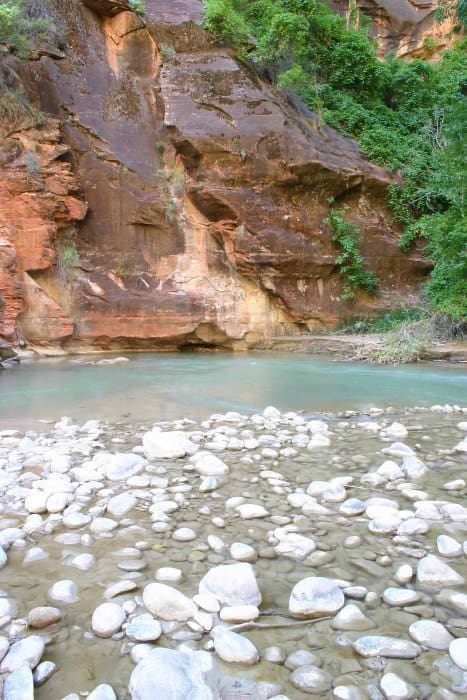
Zion Narrows Day Hike
- Trail Length: Up to 9.4 miles round trip
- Elevation Gain/Loss: 334 feet
- Time to Hike: Up to 8 hours
- Trail Difficulty: Strenuous
- Shuttle Bus Stop: Temple of Sinawava
The first thing you will want to do on the day of your day hike is to go pick up any needed supplies from one of the many outfitter stores in Springdale. I would personally pick these supplies up the day before if you are in town as it will save you from the crowds of people in the morning rush.
You will read about the supplies needed in what to wear when hiking the Zion Narrows section later in this article.
After picking up your supplies either drive into the park and park at the Zion Canyon Visitor Center or park in the town of Springdale and take a free park shuttle to the entrance of the park. The free Zion Shuttle will drop you off next to the walk-in entrance of the park where you will wait in line to pay the entrance fee before entering the park.
There is a short path that will take you from the park entrance to the visitor center. The reason you may have to park in the town of Springdale and take the bus is that the parking lot at the Zion Canyon Visitor Center fills up very early every day (usually between 8:00 am-9:00 am).
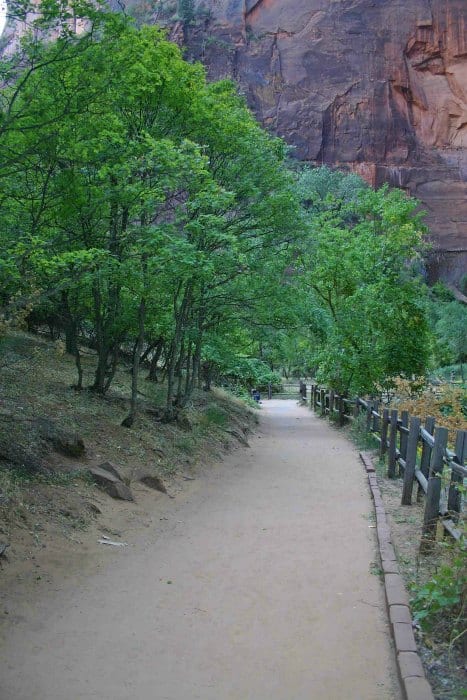
Park Ranger John Pro Tip: The best way to avoid the parking problems is to simply get a campsite in the park or stay in the Zion lodge in Zion Canyon. This will guarantee that you will have a parking spot in the park at your designated camping or lodging location.
Now that you are in the park, you can easily get anywhere in Zion Canyon, the parks visitor center, and even though the town of Springdale utilizing the easy to use the free shuttle system. If you were to camp in the park and pick up your supplies the day before, you will be skipping two long steps the morning of your hike and saving LOTS of time!
You could easily already be in the Virgin River heading upstream before most people get through the entrance of the park.
Once you arrive at the Zion Canyon Visitor Center, make sure to go inside and see what the river conditions and flow rate are for the Virgin River. The water flow rate is measured as CFS (cubic feet per second). If the river gets above 150 CFS, the narrows will be closed for all travel.
The Narrows also closes when a Flash Flood Warning is issued by the National Weather Service and remains closed for two hours after the warning is lifted.
PLEASE listen to these warnings as many people have died getting caught in a flash flood. Once you know there is no risk of a flash flood make sure to proceed outside to the parks shuttle bus that takes you into the Zion Canyon.
From the Visitor Center, take the park shuttle bus into the Zion Canyon to the Temple of Sinawava bus stop. This is the last stop on the route before heading back to the visitor center.
Make sure to use the restroom as this will be the last restroom you see until you eventually return back to the same location to take the park's shuttle bus back to the visitor center.

Take the paved Riverside Walk 1.1 miles alongside the Virgin River. This is a nice leisurely stroll with interpretative displays along the way and I always see lots of wildlife including deer and even Tarantulas.
Once you have reached the end of the paved trail you will take a few steps down to the river where the fun begins! It's time to step into the Virgin River and begin hiking upstream.
Hiking in the river is fun and exciting! Make sure to take your time and properly plant your feet. Remember that you are hiking in a river with lots of rocks that can easily cause you to twist an ankle or lose your footing.
It is also easy to get lost looking up and all-around at the natural beauty within the Zion Canyon and not pay attention to where you are walking. It is approximately two hours of hiking to reach the Orderville Canyon cutoff. Just remember that upstream travel is not permitted within Orderville Canyon.
This is the point where your jaw drops as you enter the famous Zion Narrows Wall Street. This is the point where the walls reach 1000 feet high and the walls get as narrow as 23 feet wide! The only option is to hike through the river.
This area never really sees the sun and can seem cool and eerie. It is incredibly beautiful but kinda scary at the same time. After all, you have nowhere to go if there was a flash flood event! From here you can continue hiking up to Big Springs before having to turn around as upstream travel in the Narrows is not permitted beyond Big Spring.
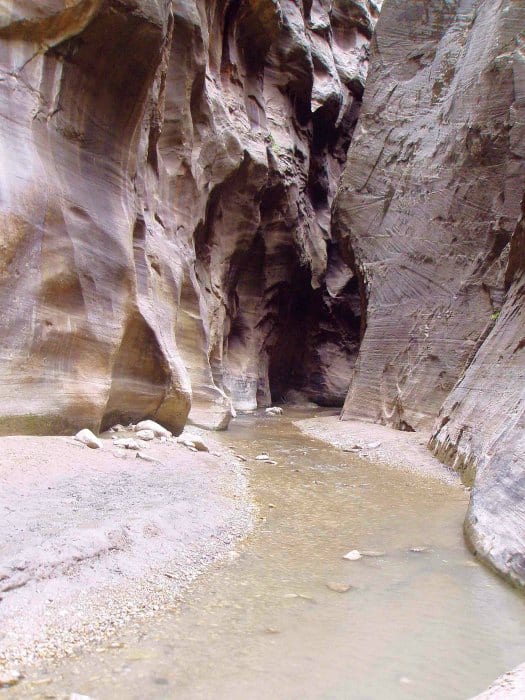
Narrows Top-Down Hike
- Trail Length: 16 Miles
- Elevation Loss: 1500 feet
- Time to Hike: 12 hours
- Trail Difficulty: Strenuous
The Top-down hike requires planning as you will either hike all 16 miles in one day or break the hike up into two days and camp along the Virgin River in the Zion Canyon.
The first thing you will need to do is hire shuttle service to drop you off at Chamberlain Ranch as this is the starting point of the Top-Down hike. The National Park shuttle service does not go this way as it is approximately an hour and a half drive outside the park. The park shuttle will pick you up after you finish the hike as it ends in the park at the Temple of Sinawava bus stop.
It is your responsibility to check with the Zion Visitor Center before heading out on your hike to check on the river conditions and the risk of flash floods. The Narrows will be closed if there is a threat of a flash flood and if the water level rises above 150 CFS.
You need to be very aware of time if you decide to complete this hike in one day, especially if it is not during the summer where the days are longer.
Remember this hike takes an average of 12 ½ hours to complete and you get dropped off at Chamberlain's Ranch at approximately 8:30 am depending on the shuttle service you hire.
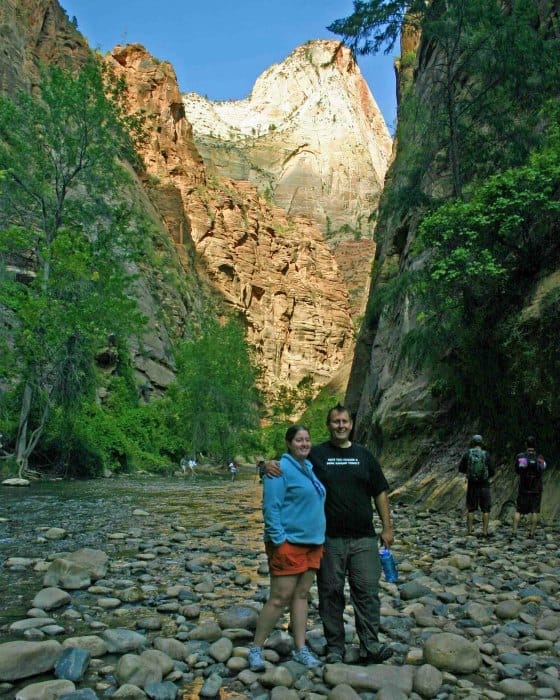
You can also anticipate the last shuttle bus from the Temple of Sinawava to leave at 9:15 PM in the summer, compared to 7:15 PM in the Fall giving you less than 11 hours to complete the hike. If you miss the last bus, you will have earned another 6 miles of hiking to get out of the Zion Canyon in the dark with wet boots. Needless to say, you will be contending not only with daylight but also not missing the park's shuttle bus.
I would also double-check with the park newspaper (available online, at the parks entrance gate and at the visitor center) to see when the last bus is running as times are subject to change by the park service.
The hours and dates can change from year to year but here is what I found for 2019 to give you an idea. Spring 2019 the last bus leaves the Temple of Sinawava at 8:10 p.m. Summer 2019 (5/12/19 through 9/29/2019) the last bust leaves the Temple of Sinawava at 9:15 p.m. Fall 2019 (9/30/2019 through 12/1/2019) the last bus leaves the Temple of Sinawava at 7:15 p.m.
The park shuttle bus does not run in the winter and the daylight is even shorter making this an extremely challenging one day hike in the winter. To give you an idea, December 1 the average sunrise is approximately 7:30 am and sunset at 5:15 p.m. That's only 9 hours and 45 minutes between sunrise and sunset and again, the shuttle buses tend to drop you off at Chamberlain's Ranch at 8:30 a.m. giving you only 8 hours and 45 minutes for a 12 hour and 30-minute hike.
To make it more challenging, the National Parks shuttle bus does not run in the winter and would require you to either park your personal vehicle at the Temple of Sinawava stop or make arrangements to be picked up at a certain time.
The top-down hike starts off when you get dropped off at Chamberlain's Ranch. The first three miles are on a gravel road and goes by rather quick.
You reach the first narrows at approximately three and a half hours into the hike. Deep Creek enters the Canyon after five hours of hiking and campsites start to appear between here and Big Springs which is about seven hours into the hike.
Shortly after arriving at Big Springs comes the famous Wall Street. This is an area you will want to enjoy and photograph so take your time. It is also the first time you will run into day-use hikers in the Zion Canyon. Shortly after exiting Wall Street, you will see the intersection of Orderville Canyon as you hit the 10-hour mark.
You have a couple more hours of hiking in the Virgin River before you get out of the river at the top of the Riverside Walk Trail. From here, you have an easy trail back to the Temple of Sinawava Trailhead.
Make sure to really enjoy yourself while visiting the upper part of the canyon. You will find much more solitude and the ability to really appreciate this rugged wilderness before running into lots of other hikers.
Zion Narrows Permit
You will also have to obtain a wilderness permit for all through hikes of The Narrows and its tributaries. All permits (including those with reservations and those awarded through the lottery for The Subway and Mystery Canyon) must be obtained in person on the day before or day of the trip at the Zion Canyon or Kolob Canyons Visitor Centers.
You can reserve a spot for your trip to the Narrows on the Calendar Reservation System. Please note that calendar reservations are not permits.
Once you have secured a calendar reservation, you must pick up your permit at either the Zion Canyon or Kolob Canyons Visitor Center before beginning their trip.
Calendar reservations can be made online during a three-month time frame. On the fifth day of every month at 10:00 am MT, reservations for trips a month out become available.
If they are still available, reservations can be made until 5:00 pm MT on the day before your trip.
There is a $5.00 non-refundable fee for an online calendar reservation.
Remember that if the flow of the Virgin River is 150 CFS or above or there is a threat of a flash flood, the National Park Service will not issue any permits for hiking the Zion Narrows for visitor safety.
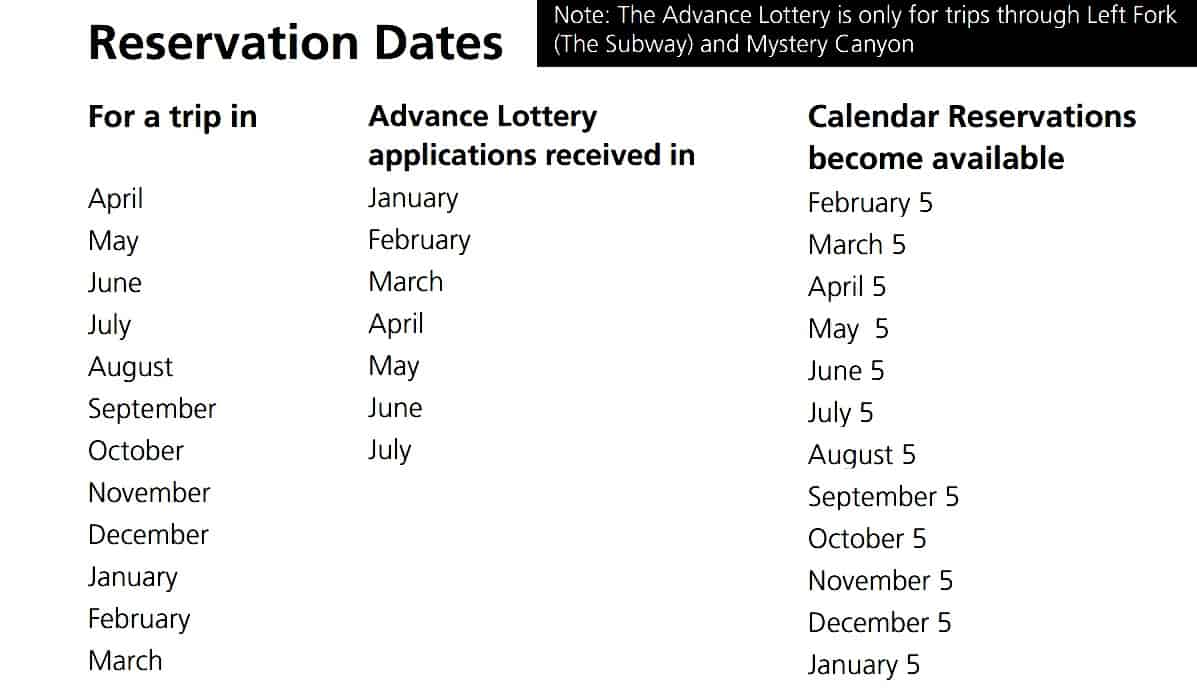
Approximately one-third of wilderness campsites are available as Walk-in Permits and can be obtained the day before your trip starts. Any slot canyon or climbing permits not taken through the reservation system are available as Walk-in Permits.
Wilderness campsites, climbing areas, and slot canyons that are not listed in the reservation system are only available as Walk-in Permits. Plan ahead and obtain a reservation to avoid any disappointment.
The non-refundable Wilderness Permit fee is:
$15 for 1-2 people
$20 for 3-7 people
$25 for 7-8 people
Large Groups are not allowed in the Zion Narrows.
Zion Narrows Campsites
There are twelve numbered sites in the Zion Canyon between Deep Creek intersection and Big Springs (See Map Above). Only one-night stays are allowed in the canyon and overnight trips must start from Chamberlain’s Ranch.
The National Park Service recommends reservations for weekend trips but I would try to get a reservation if I knew that I was going. Campsite capacity is limited and only two sites can accommodate groups of more than six people.
Make sure to check out the photos of the 12 campsites in the Narrows.
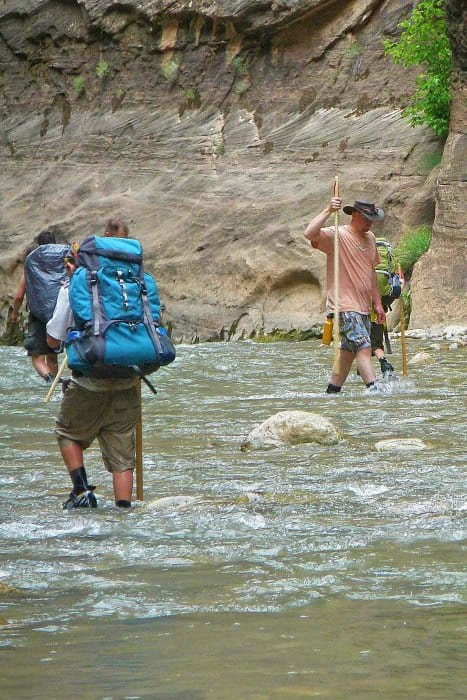
What to wear when hiking the Narrows?
Wearing the right equipment can be the difference between having a fantastic time or ending up cold, wet, having blisters or even worse injured. Everything listed below is designed specifically to maximize your enjoyment, safety, and comfort.
Zion Narrows Gear Rentals
Most outfitters have several package deals like a summer package that includes boots, neoprene socks, and a wooden stick for approximately $25. They will also have a spring/fall package that will also include Gore-Tex Pants and a winter package that includes a dry suit.
Boots: You can rent boots for several outfitters in Springdale. The boots are a canyon type boot designed to keep your feet dry, rigid ankle protection and excellent soles designed for gripping in wet slippery conditions.
I personally used an old pair of hiking boots the first time I hiked the Narrows and they worked. My feet definitely got cold but it was the summer and I was not too worried.
The downside was that it was the only time I used these boots on my trip as they were soaked and took forever to dry. Once they dried, they fit a little differently and I ended up throwing them out. I was not disappointed as they were an older pair of boots but I ended up dragging a wet pair of boots all over the place on a two week trip to the southwest.
If you would like a good quality pair of boots to explore canyons, many people highly recommend this canyon shoe.
Socks: Socks are as important as a good pair of boots! Again, if you rent equipment from one of the outfitters in Springdale, they will most likely provide neoprene socks with a pair of canyon boots. Neoprene socks will help insulate your foot and prevent blistering and discomfort accompanied by hiking in wet boots.
Wooden Stick: a wooden hiking stick for stability and balance and can hold up much better in the Narrows than regular trekking poles. It is easy to slip and fall in the river (I know from experience!) and you will naturally grab your wooden hiking stick for dear life when it happens.
The stick easily gets caught up in the rocks and if you have a nice pair of retractable hiking poles they can easily get bent. That's a real bummer when you paid over $100 for a nice pair of trekking poles!
Zion Narrows Rental Companies
I wanted to list a couple of the outfitters located in Springdale, Utah. They are located just outside the entrance of the park and are equipped for all your needs for hiking the Zion Narrows.
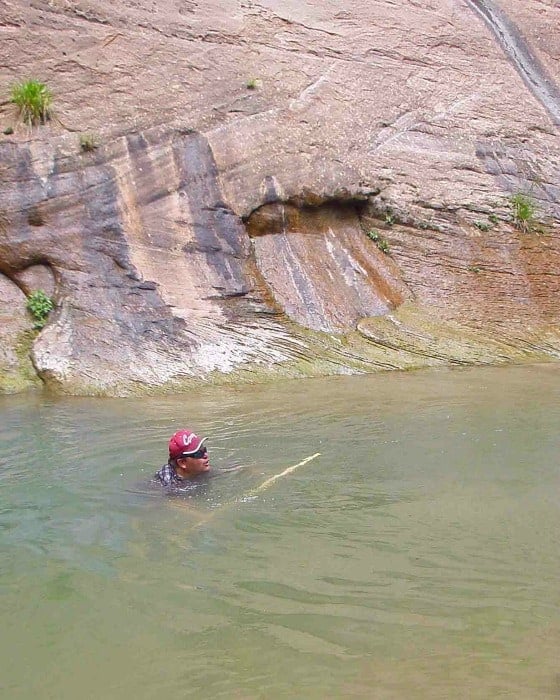
Zion Narrows Packing List
The water level varies drastically within the Zion Canyon. I might have encountered water up to my knees on my first hike into the Zion Canyon however my last trip was very different.
Each member of my group found themselves treading water in spots as we waded through water up to my neck and I'm 6'3" tall! This means if you don't have the right equipment, you and all of your equipment will end up soaked.
You can rent some of this equipment through the above-named outfitters or bring your own supplies. Here is a list of recommendations.
- 10 Essentials including a First Aid Kit
- Hiking boots with ankle support
- Socks: Neoprene or wool, definitely not cotton.
- Shorts for Hiking
- Extra Clothes: You will want to bring something to keep you warm as it gets considerably cooler in the canyon.
- Extra food/Water. It is recommended to carry at least one gallon per person per day. It is also recommended to not drink water from the river. Water in this river has passed over rangeland and may be contaminated with illness-causing bacteria. Treat the water you collect by filter, tablets, or by boiling. Hikers are encouraged to carry in all of their water.
- Headlamp with Batteries: I personally like the option of being able to put in 3 AAA Batteries as I can carry extra. Why? I have accidentally hit the power button and ran my batteries out and go to grab my flashlight only to find the battery is dead. Backup batteries are there to save the day as there are no recharging ports in the Narrows!
- Waterproof bags or a Dry Bag Backpack can be extremely useful for carrying food or additional clothing. Dry warm clothes can be the key to having a fun experience.
- Personal wilderness toilet bags must be carried by everyone completing the Top-down hike.
- Underwater camera and/or a waterproof case for your phone.
- Garbage bags for all your food and garbage (Practice Pack-It-In, Pack-It-Out while in Zion Canyon)
- Topographic map and compass (GPS is not very effective in canyons)
- Sunscreen, Sunglasses and a Hat.
How to get to the Zion Narrows
Directions to the Riverside Walk Trailhead (Beginning of the Narrows Day Hike)
Due to the limited parking available within the Zion Canyon, you may be required to park your vehicle in the city of Springdale, the park visitor center or at your designated camping/lodge site and take the park's free shuttle into the Zion Canyon.
Don't worry, it is easy to use and the National Park Service put together this great video and map explaining the shuttle bus system.
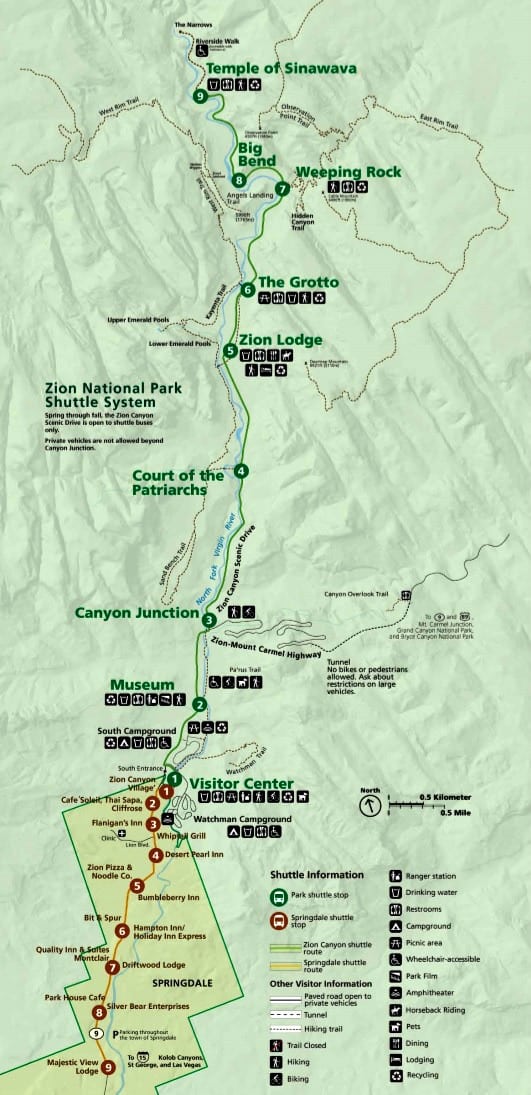
If you plan on doing the day hike in the winter, simply drive up to the Temple of Sinawava Trailhead!
Directions to Chamberlain's Ranch Chamberlain’s Ranch (Top-Down Hike)
Chamberlain's Ranch is a 1.5-hour drive from Zion Canyon starting off on paved roads before turning into dirt roads. The dirt roads are passable for normal cars only when dry. When wet, they may be impassable even for four-wheel-drive vehicles. Snow also closes the road in winter.
From the park’s East Entrance, drive 2.5 miles east on Route 9. Turn left on a paved road and continue 18 miles to a bridge that crosses the North Fork of the Virgin River. Turn left beyond the bridge and drive one-quarter mile to the gate of Chamberlain’s Ranch. Please close the gate behind you.
Drive one-half mile farther and park just before the road crosses the river. To begin your hike, cross the river and follow the road for approximately 3 miles. Enter the river at the end of the road past the old cabin. Chamberlain’s Ranch is a private ranch outside Zion National Park. Please respect private property.
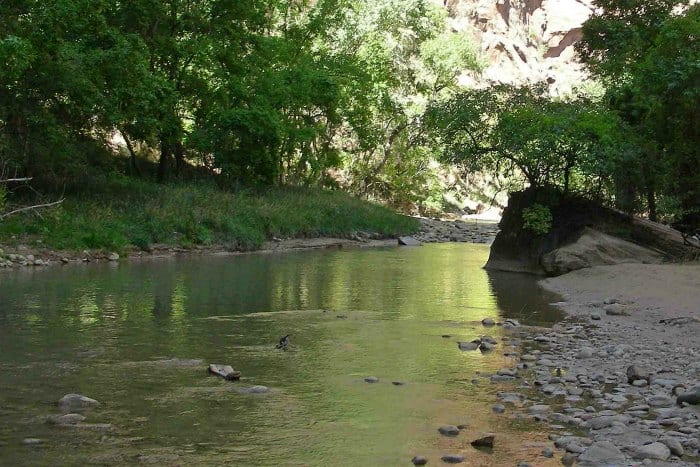
What is the Best time to hike the Zion Narrows
In an average year, high water due to snowmelt makes The Narrows impassable until late May. Most people like to hike the Zion Narrows from late spring through Summer. The downfall to this time of year is the risk of flash flooding.
The fall is the ideal time for backpacking trips in the park. Canyoneering trips through The Narrows and other slot canyons are best before mid-October as cooler temperatures may require wetsuits and other specialized gear.
Winter snow in the high country will prevent you from accessing Chamberlain's Ranch and the upper Narrows. Only day use hiking will be available with specialized equipment to keep you warm. The nice part of late fall through the winter is that you will see very few people in the canyon compared to the crowds that you will see in the summer.
Weather
The park typically experiences a monsoon season from mid-July through mid-September with an increased risk of severe thunderstorms and dramatic flash flooding. Also, remember that it can be 100 Degrees in Zion with the sun but as soon as you get into the slot canyon you can be covered in shade, the river is much cooler and a breeze that can chill most people.
I prefer to dress in layers to keep me warm and usually carry a few extra articles of clothing with me in my bag.
Below is a list of average temperatures by month along with average precipitation. Definitely good things to be aware of when hiking the Narrows.
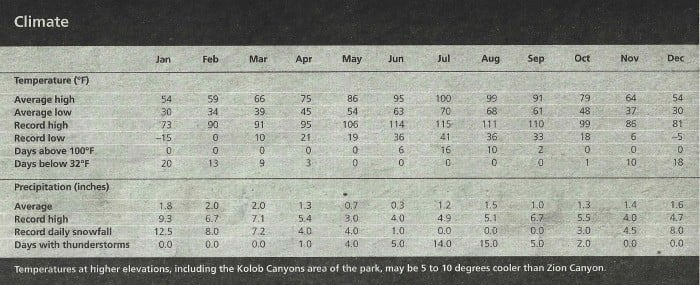
Flash Floods
The Virgin River is, for the most part tame, but its real power comes from flash flood events when a rainstorm hits further upstream and which is often unnoticeable to anyone in the Zion Canyon.
Flood events have occurred for centuries on the Virgin River and have created the canyon walls we hike through today, some as tall as 1000 feet high and only 23 feet wide in an area of the Zion Canyon called Wall Street. These canyons are beautiful but should also command respect and a close eye to the weather forecast for all visitors to the canyon.
There are several factors making flash floods so dangerous. Flash floods often come by complete surprise to an unsuspecting visitor, they also bring with them lots of debris including large logs and boulders along with extremely strong currents.
If you are walking through a slot canyon like the Narrows, you can have nowhere to go but up and sometimes going up isn't an option as the walls are high and too steep to climb leaving you trapped in a flash flood.
Notice in the video below the amount of debris in the water. This debris dramatically reduces the chance of survival of getting caught in a flash flood.
I don't want people to be afraid to hike the narrows but come prepared. The last thing I want to hear is someone getting caught in a flash flood.
I can almost guarantee that if you come prepared to hike the Zion Narrows, you will leave Zion beyond excited to go home and tell everyone about this amazing hike. It really is one of the most amazing hikes I have ever done and I am sure that I will go back several more times in my life.
Zion National Park Entrance Fee
Park entrance fees are separate from camping and lodging fees.
Park Entrance Pass - $35.00 Per private vehicle (valid for 1-7 days from the date of purchase)
Park Entrance Pass - Motorcycle - $30.00 Per motorcycle (valid for 1-7 days from the date of purchase)
Park Entrance Pass - Snowmobile - $20.00 Per Snowmobile (valid for 1-7 days from the date of purchase)
Per-Person Entrance Pass - $20.00 Visitors 16 years or older who enter on foot, bicycle, or as part of an organized group not involved in a commercial tour.
Annual Park Entrance Pass - $70.00, Admits pass holder and all passengers in a non-commercial vehicle. Valid for one year from the month of purchase.
$20.00 for Non-Commercial Group (16+ persons)
$70.00 for Commercial Van with 7-15 seats
$80.00 for Commercial Mini-Bus with 16-25 seats
$190.00 for Commercial Motor Coach with 26+ seats
Learn more about National Park Passes for parks that have an entrance fee.
$80.00 - For the America the Beautiful/National Park Pass. The pass covers entrance fees to all US National Park Sites and over 2,000 Federal Recreation Fee Sites for an entire year and covers everyone in the car for per-vehicle sites and up to 4 adults for per-person sites.

Buy your pass at this link, and REI will donate 10% of pass proceeds to the National Forest Foundation, National Park Foundation, and the U.S. Endowment for Forestry & Communities.
National Park Free Entrance Days -Mark your calendars with the five free entrance days the National Park Service offers annually.
Where to stay when visiting Zion
Zion Lodge - Spend the night in the heart of the Zion Canyon giving you the easiest access to some of Zion's most popular trails! This review includes amenities, photos, and video of what it is like to stay in the lodge.
Zion Cabins- The cabins are located next to the Zion Lodge in the heart of the Zion Canyon. The review includes photos, video, and a list of amenities.
The majority of lodging outside of the park is located in Springdale or Virgin Utah.
Under Canvas Zion - Sleep under the stars in a glamping tent.
Cliffrose Springdale, Curio Collection by Hilton - 4-star hotel. Take advantage of a roundtrip airport shuttle, a grocery/convenience store, and a terrace at Cliffrose Springdale, Curio Collection by Hilton. With a private beach, this hotel is the perfect place to soak up some sun. In addition to a firepit and a garden, guests can connect to free in-room Wi-Fi.
Best Western Plus Zion Canyon Inn & Suites - Consider a stay at Best Western Plus Zion Canyon Inn & Suites and take advantage of a free breakfast buffet, laundry facilities, and a 24-hour health club. For some rest and relaxation, visit the hot tub. In addition to a 24-hour business center, guests can connect to free in-room Wi-Fi.
La Quinta Inn & Suites by Wyndham at Zion - Consider a stay at La Quinta Inn & Suites by Wyndham at Zion Park/Springdale and take advantage of free continental breakfast, a grocery/convenience store, and laundry facilities. Stay connected with free in-room Wi-Fi, and guests can find other amenities such as a gym and a 24-hour business center.
Hampton Inn & Suites Springdale/Zion - Take advantage of free breakfast, dry cleaning/laundry services, and a 24-hour gym at Hampton Inn & Suites Springdale/Zion National Park. Stay connected with free in-room Wi-Fi, and guests can find other amenities such as a 24-hour business center and a snack bar/deli.
Holiday Inn Express Springdale - look forward to a grocery/convenience store, a terrace, and shopping on site at Holiday Inn Express Springdale - Zion National Park Area, an IHG Hotel. For some rest and relaxation, visit the hot tub. In addition to a firepit and a garden, guests can connect to free in-room Wi-Fi.
Fairfield Inn & Suites by Marriott Virgin Zion - free breakfast buffet, a grocery/convenience store, and a terrace at Fairfield Inn & Suites by Marriott Virgin Zion National Park. Active travelers can enjoy bicycling at this hotel. For some rest and relaxation, visit the hot tub. Free in-room Wi-Fi is available to all guests, along with dry cleaning/laundry services and a fireplace in the lobby.
Additional Zion NP Resources
Zion National Park Camping – Learn more about each of the campgrounds in the park and what to expect.
Zion Hiking Guide – Check out the top hiking trails you do not want to miss! From easy walks to full adventures of hiking Angels Landing.
Zion Lodge - Find out what it is like to stay in the Zion Lodge
Zion National Park Cabins - Check out photos and videos of staying in a cabin in the heart of Zion.
Check out our complete Zion NP Guide.
Make sure to follow Park Ranger John on Facebook, Instagram, Pinterest, and TikTok





Leave a Reply